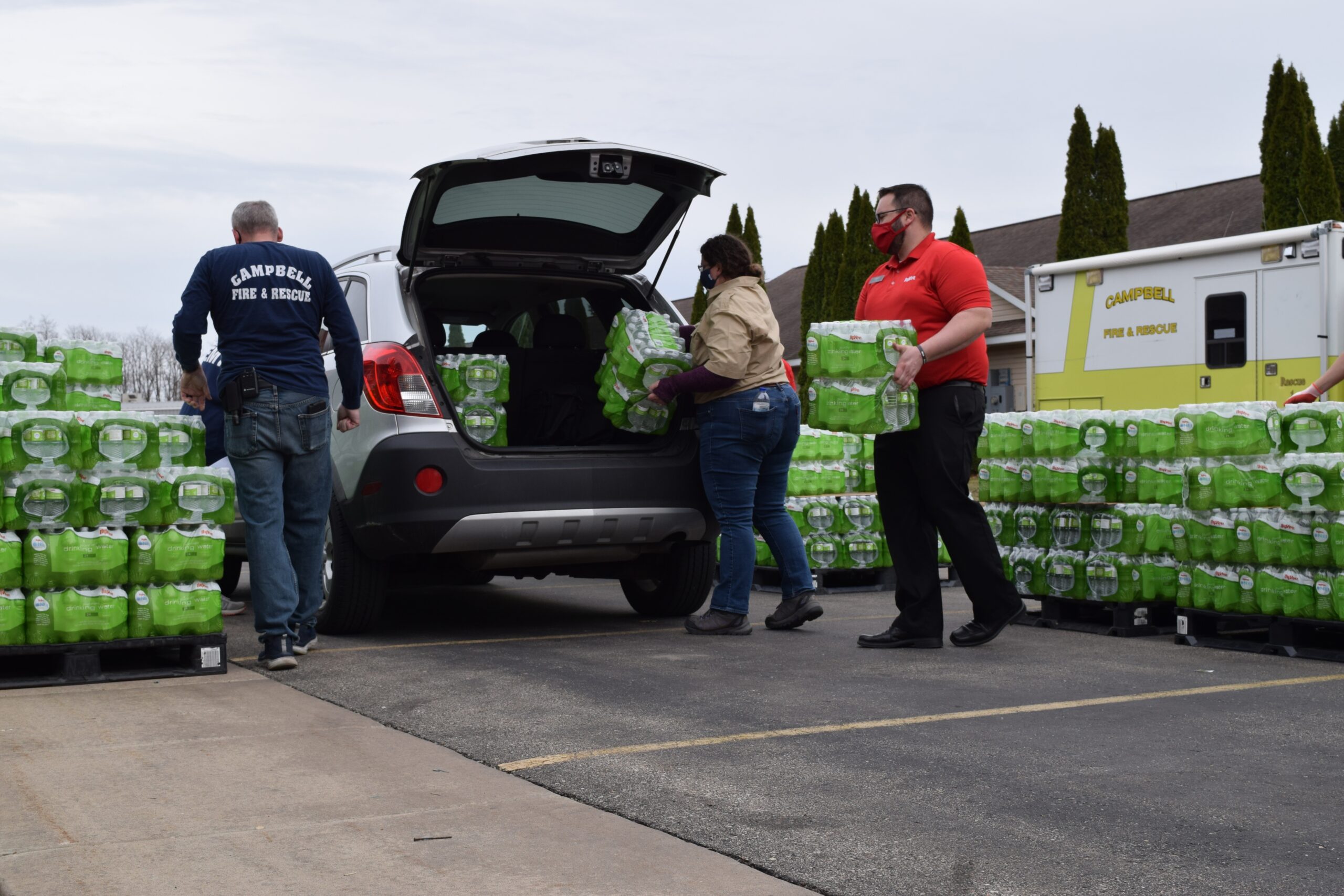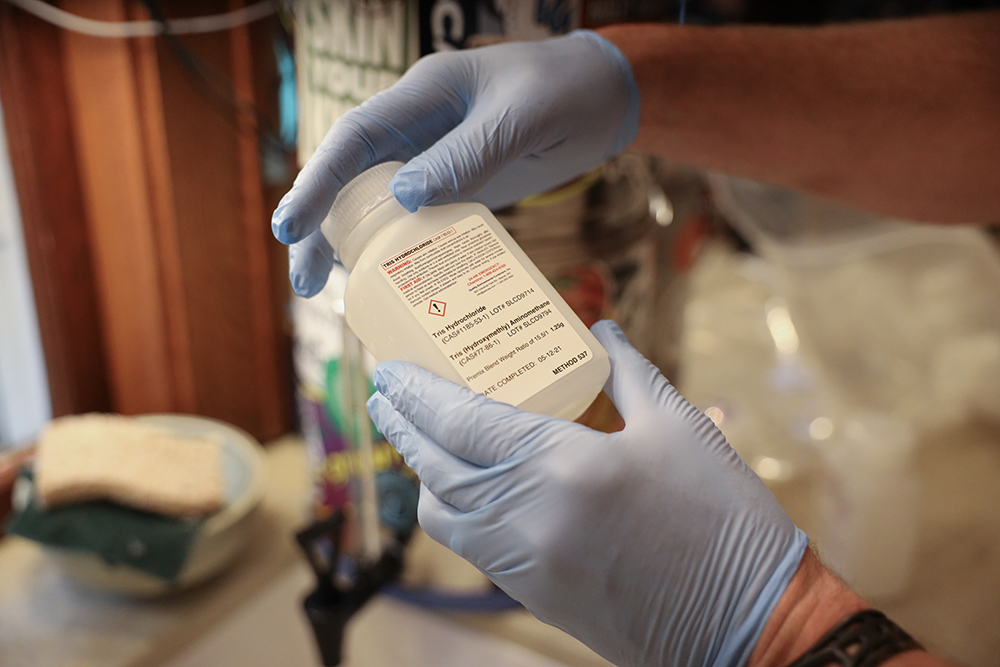State environmental regulators can begin crafting groundwater standards for more PFAS chemicals and pesticides after the Natural Resources Board voted to move the process forward Wednesday. The effort to regulate those substances has been met with opposition by industry and municipal groups, while environmental groups support setting standards to protect public health.
The Wisconsin Department of Natural Resources will begin developing individual groundwater standards for a dozen PFAS chemicals and six pesticides, as well as combined standards for four additional PFAS substances. The agency also received approval to begin setting maximum contaminant levels for the PFAS chemicals in drinking water.
The DNR is moving forward with regulation after the Wisconsin Department of Health Services recommended setting standards for the 22 substances last fall. Health officials used federal groundwater quality standards when available and scientific research to develop a baseline for each substance.
Stay informed on the latest news
Sign up for WPR’s email newsletter.
“The reason that we’re doing this is that there’s a meaningful opportunity to protect public health,” said Steve Elmore, the DNR’s program director for drinking water and groundwater.
Groundwater is used by more than two-thirds of Wisconsin residents for their drinking water, according to the DNR.
In comments submitted to the agency, multiple industry and municipal groups like Wisconsin Manufacturers and Commerce and the wastewater division for the Municipal Environmental Group questioned the science that formed the basis for standards recommended by health officials. Industry groups called the proposed standards for PFAS unlawful, but the DNR argues it has legal authority under state law to maintain a safe drinking water program.
Meanwhile, groups like the Municipal Environmental Group and the Wisconsin League of Municipalities urged state regulators to wait for federal standards.
“While municipal wastewater facilities are not a manufacturer of PFAS, they will be impacted by numeric effluent standards,” wrote Toni Herkert, the League’s government affairs director. “EPA is still gathering the scientific information necessary to develop PFAS standards. Wisconsin should avoid getting ahead of the EPA when setting standards.”
Efforts to regulate the chemicals were delayed under the Trump administration, but the Biden administration is now moving to set a drinking water standard for two PFAS chemicals: PFOA and PFOS. The Environmental Protection Agency has issued an interim health advisory level of 70 parts per trillion.
Elmore noted it will take federal environmental regulators six years to set maximum contaminant levels in drinking water for PFOA and PFOS. He added it would take seven to 10 years for the EPA to come up with maximum levels for PFAS compounds the DNR is proposing to regulate.
In the absence of federal guidelines, Wisconsin is already crafting PFAS standards for drinking water, groundwater and surface water for PFOA and PFOS. State health officials have proposed a combined groundwater standard of 20 parts per trillion those chemicals.
Carly Michiels, government relations director for environmental group Clean Wisconsin, told the board Wednesday that Wisconsin residents need state leadership in the absence of federal standards.
“These substances have serious known public health impacts, disproportionately affect low-income communities and communities of color, decrease home values, harm recreational fishing and wildlife health and may impact the dairy industry,” said Michiels. “Other states have also already moved forward with similar protections.”
PFAS, or perfluoroalkyl and polyfluoroalkyl substances, have raised concern because they don’t break down easily in the environment. The so-called “forever chemicals” have been found in firefighting foam and everyday products like nonstick cookware. They’ve been linked to an increased risk of kidney and testicular cancers, thyroid disease and fertility issues.
Board members touched on concerns raised among various groups that support and oppose setting standards, highlighting the health and economic impacts of regulating the chemicals. Groups questioned how the DNR arrived at its economic impact analysis that estimated additional sampling and analysis would cost regulated facilities up to $5 million per year.
Elmore said the DNR intends to be transparent as it addresses concerns over research, input and the costs related to implementing standards.
Board member Bill Bruins was the lone dissenter in voting against moving the process forward. He said there were too many questions surrounding the cost and research used to propose standards, arguing regulators relied on “shabby” peer-reviewed science.
“I’m not opposed to clean water,” said Bruins. “We need to be careful about what we’re proposing here.”
The DNR said it received 125 comments in support of crafting standards and 10 comments opposed to outlining numeric levels for the chemicals at this time. The agency must submit any final rule on proposed standards for approval by fall of 2023.
Industry and municipal groups have been at odds with the DNR and environmentalists over regulating PFAS. Wisconsin Manufacturers and Commerce has challenged the DNR’s efforts to require clean up and sampling of the chemicals in two separate lawsuits.
The business group has also been an outspoken critic of the agency’s efforts to set numeric targets for the chemicals, including under an emergency rule that was weakened by GOP lawmakers in December. The rule aimed to implement a law barring the use of firefighting foam that contains PFAS except in emergencies and limited circumstances.
The group is backing a proposal making its way through the Legislature that would provide $10 million in grant funding for communities, but the bill would prevent local governments from suing polluters to pay to clean up contamination if communities accept the funds.
A proposal introduced by Gov. Tony Evers and Democrats that would create a grant program for communities to address PFAS and set interim standards for PFAS in drinking water and groundwater has not yet received a public hearing.
Public Pushes Back Against Board Chair
Members of the public pushed back against the chair of the Natural Resources Board on Wednesday after he decided stay on the board past the end of his term.
Chair Fred Prehn decided not to leave his seat until the Republican-controlled Senate confirms nominations made by Evers.
The governor announced the appointments of Sandy Naas and Sharon Adams on April 30 to fill vacancies created by the expiring terms of Prehn and board secretary Julie Anderson. Only Anderson stepped down. Both were appointed by former Republican Gov. Scott Walker for six-year terms that expired May 1.
Laura Lane, chair of Sierra Club Wisconsin, delivered a petition to the board with more than 300 signatures calling on Prehn to step down.
“By refusing to graciously and honorably vacate his seat as his past predecessors have done, Prehn is thwarting the will of the people,” said Lane during the board’s open forum. “The people elected Evers and gave him the right to name a new appointee to the National Resources Board. Prehn is preventing Naas from taking her rightful seat and effectively silencing her voice.”
Lafayette County Board supervisor Kriss Marion told the board it’s unethical for Prehn to hold onto his seat.
“It smacks of the sort of instability and political gamesmanship we’ve seen tearing the fabric of democracy at the national level where the peaceful transfer of power has been disrupted,” Marion said.
Nick Christianson, a dentist in Madison, attacked Prehn’s decision. He said the board chair should “go back to Wausau” and try to salvage his reputation, a comment that prompted a rebuke by vice chair Greg Kazmierski.
Cheryl Heilman, deputy chief counsel for the DNR, said a member that’s been appointed by the governor can begin immediately serving if there’s a vacancy on the board.
“But, the Supreme Court has looked at this issue back in the 1960s and ruled that someone who is duly serving, being appointed and confirmed by the Senate, may hold over until their replacement is not only appointed by the governor, but also confirmed by the Legislature,” Heilman said.
Republicans in the Senate have held off on confirming some of Evers’ appointments. Prehn previously told WPR the move is not political, saying the board could use his leadership on issues ranging from the wolf hunt to water quality concerns.
DNR To Begin Crafting Revisions To Wolf Harvest Regulations
Also Wednesday, the board gave approval for state wildlife managers to begin revising wolf harvest regulations. The DNR is proposing to end the night hunting of wolves, shorten the period for registering harvested wolves and provide tags for specific hunting zones.
Scott Karel, rules specialist for the DNR’s Bureau of Wildlife Management, explained the DNR wants to end night hunting of wolves to aid with timely closure of the season. In February, state-licensed hunters blew past the 119-wolf quota and harvested 218 wolves in less than 72 hours.
“We think that consistent shooting hours will improve our ability to monitor the harvest and timely reporting of the harvest, so that’s the primary reason why we’re looking to make night hunting more consistent,” Karel said.
Hunting wolves with hounds is currently not allowed at night. Night hunting is allowed for coyote, fox and raccoon in Wisconsin. Those species would not be impacted by the proposed revisions since the regulations are specific to wolves.
The DNR has faced criticism over its handling of the state’s first wolf hunt in six years. The Natural Resources Board approved an overall quota of 200 wolves that was split between the state and Wisconsin’s Ojibwe tribes. The agency has said the number of tags awarded to hunters and a requirement in state law to give hunters 24-hour notice before closing the season made it difficult to prevent overharvest.
Hunters such as Mike Brust with the Wisconsin Bowhunters Association feel the wolf harvest revisions are a knee-jerk reaction to the February hunt.
“As a predator caller, the elimination of night hunting will pretty much eliminate my and others’ ability to hunt wolves with our preferred method of hunting,” said Brust. “Predators, including wolves, are most active and feeding at night.”
Animal rights groups don’t support recreational hunting of wolves. But if a hunt is going to occur, Megan Nicholson, Wisconsin state director for the Humane Society of the United States, said barring any night hunting of wolves is a step in the right direction.
“Earlier this year, it was made abundantly clear that additional restrictions are needed through rulemaking if the DNR is going to hold any future wolf hunts,” said Nicholson.
Nicholson recommended the agency limit the number of hunters that can hunt in groups and create buffer zones around territories ceded by tribes to the government under federal treaties, as well as prohibit hunting from snowmobiles or motorized vehicles.
The DNR aims to bring an emergency rule before the board in September that would bar night hunting and shorten the registration window for this fall’s wolf hunt in November. The DNR hopes to have permanent rules in place as early as next spring.
Wisconsin Public Radio, © Copyright 2024, Board of Regents of the University of Wisconsin System and Wisconsin Educational Communications Board.




